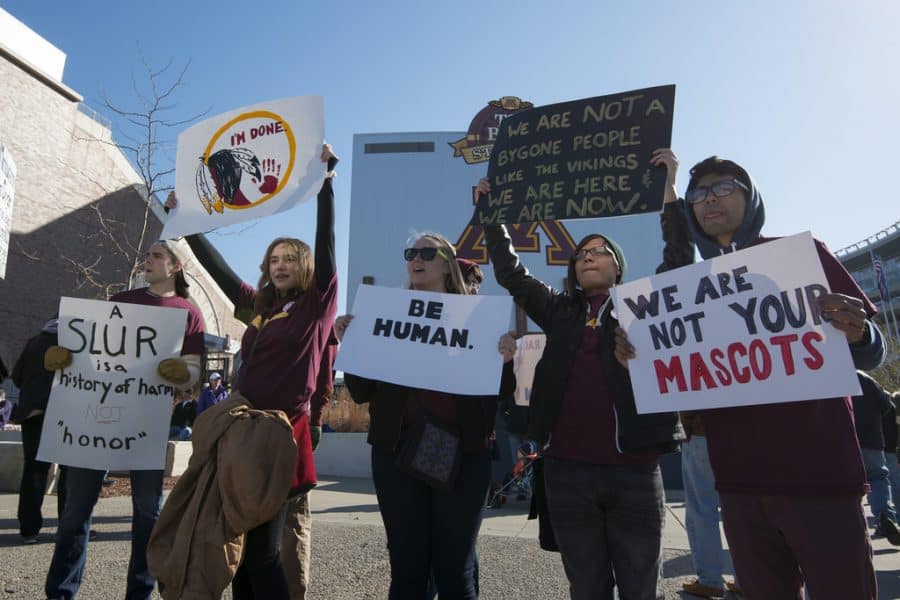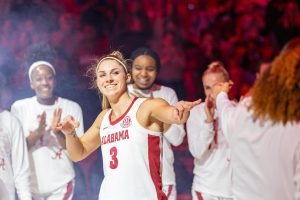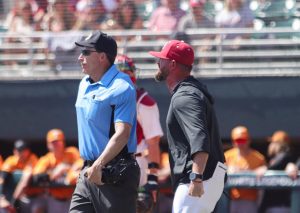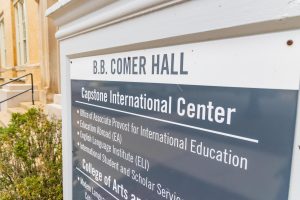Native American mascots create ‘double oppression’
November 20, 2018
A traditional spectacle of college football will take place in Tallahassee, Florida on Saturday. Before the game kicks off in Doak Campbell Stadium, Florida State Seminoles fans will roar with applause as their unconventional mascots take to the field.
Chief Osceola, an FSU student dressed in Seminole-inspired garb, will lift a flaming torch over his head while guiding Renegade, an Appaloosa horse, around the field. As the crowd noise reaches its fever pitch, with fans and students joining in on the “war chant” and tomahawk chop, Renegade will rush to midfield as Osceola spikes the flaming, feathered torch into the Seminole logo on the 50-yard line.
Oh, and then they’ll play football.
But University of Alabama professor Andrew Billings is less concerned about what comes next. In a new book with former UA professor Jason Black, the two authors pore over the Native American mascots, logos, nicknames and rituals found in collegiate and professional sports. Black, who now chairs the communication studies department at The University of North Carolina at Charlotte, joined Billings over video call Tuesday night for a discussion of their research.
Skyping in from Charlotte, North Carolina, Black was quick to mention the geographical relevance of the subject matter. Tuscaloosa, Black pointed out, is named for Chief Tuskaloosa. The Chief’s name, translated from the Choctaw, is the namesake of the Black Warrior river, which cuts through the heart of this college town. Black himself was only a few minutes away from important Native American land.
The effect was not lost on Black, who noted that the use of Native American stereotypes and caricatures in popular culture alongside the long-ago colonization of Native American land has resulted in “a double oppression.”
Before Black could take the audience through a brief history of Native American perception in popular culture, Billings laid out the criteria used to develop their book. The project’s first priority was to separate out the facets of Native American portrayals in mascoting. This resulted in a trinity of mascot analysis: names, images and rituals. Once they had parsed out their categories, it was time to hit the surveys.
Billings and Black surveyed over 1,000 people on the offensiveness and acceptability of various Native American mascots, nicknames and traditions. That data became the basis of their book, “Mascot Nation: The Controversy over Native American Representations in Sports.”
Billings served as the numbers guy, while Black was more interested in case studies. Chief Wahoo, the face of the Cleveland Indians baseball team, was one of the most integral examples in their work. Wahoo, explained Black, is a “racial icon.” Wahoo is the navy and red team logo. He has a cartoonishly crimson face and triangle-shaped eyes, a feature Black attributes to “teepee” imagery.
“You’ll see that he stands out,” Black said. “There’s no doubt about it.”
Citing photos of fans in redface, Black said that some Indians fans have become desensitized to the cultural appropriation, while others have taken to removing Wahoo from their Indians merchandise entirely. In a practice called “de-chiefing,” some fans have removed the Wahoo patch from caps and jerseys, leaving behind a tattered outline of white thread. The Indians plan to remove Wahoo from uniforms in 2019.
Meanwhile, back in Tallahassee, the situation is more complicated. Black said the FSU athletics department has received the seal of approval from the actual Seminole nation of Florida. Osceola’s costume is in genuine Seminole patchwork style, and it was designed and approved by the nation. However, the Seminole nation of Florida is not the only nation with a claim to the name. The Seminole Nation of Oklahoma is the largest government using the Seminole name, and some members of their nation feel uneasy about the FSU football custom, Black said.
To his point, David Narcomey, a Native American activist and member of the Seminole Nation of Oklahoma referred to the Osceola ritual as a “minstrel show” in a 2011 interview with NewsOK. Narcomey was also part of the 2005 NCAA self-review that resulted in the banning of many Native American mascots. FSU was given a waiver from the ban after significant support from the Seminole community in Florida and Oklahoma. However, in a 2013 official statement, the Seminole Nation of Oklahoma declared that the nation “condemns the use of all American Indian sports-team mascots in the public school system, by college and university level and by professional sports teams.”
The case of Pekin High School is another studied in the book, this time by Billings. When the town of Pekin, Illinois was established, said Billings, the founders mistakenly assumed that Peking, China, was exactly on the other side of the globe. In order to “honor” that “Chinese connection,” the town settled on an anti-Chinese slur as its high school mascot.
It’s those detailed, complicated arguments and eccentricities that Billings and Black investigate in their new book.
Assistant Dean George Daniels organized Tuesday’s book talk alongside the Department of Journalism and Creative Media; the event served as a celebration of Native American Heritage Month. “Mascot Nation” is published by Illinois Press and now available via Amazon.


















![UPDATE | New details have emerged about U.S. Immigration and Customs Enforcement’s arrest of doctoral student Alireza Doroudi.
— Yesterday, a University spokesperson confirmed that a doctoral student was arrested by federal immigration authorities, without providing the student’s name, declining to share specific information due to federal privacy laws.
“International students studying at the University are valued members of the campus community, and International Student and Scholar Services is available to assist international students who have questions,” said Alex House, associate director of media relations for the University. “UA has and will continue to follow all immigration laws and cooperate with federal authorities.”
— An employee at the Pickens County Jail confirmed that Doroudi is being held there, adding that the facility typically sends ICE detainees to a detention facility in Louisiana.
— The Department of Homeland Security provided a statement about Doroudi’s arrest:
“ICE HSI [Homeland Security Investigations] made this arrest in accordance with the State Department’s revocation of Doroudi’s student visa. This individual posed significant national security concerns,” a DHS spokesperson said. The statement did not provide details about why it claimed Doroudi posed national security concerns.
— Students for Justice in Palestine at UA, formerly known as Bama Students for Palestine, said in a statement on social media Thursday that it was “outraged” to learn of his detainment and that he "was not involved, nor has he ever been involved in any organizing or protests related to our organization."
This is a developing story and will continue to be updated. Read the updates at the link in our bio.](https://scontent-iad3-2.cdninstagram.com/v/t51.75761-15/486944895_18492822301025566_6944596333023050206_n.jpg?stp=dst-jpg_e35_tt6&_nc_cat=107&ccb=1-7&_nc_sid=18de74&_nc_ohc=hnp26Pzwsm0Q7kNvgH09W0S&_nc_oc=AdmIBEMuR_aRgaBd00Hlot3E59Vj_4lQyCImLLgp8CLdbxpSmLU25dhU_MO_Zul-qcU&_nc_zt=23&_nc_ht=scontent-iad3-2.cdninstagram.com&edm=AM6HXa8EAAAA&_nc_gid=JoP4PtbuUvKZPgo_irMz6g&oh=00_AYHaxc2fU_0Gtxir1ovI3S3ePEm5ochZlpkudswEk4pOlA&oe=67F0D930)


